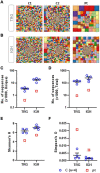Novel NHEJ1 pathogenic variant linked to severe combined immunodeficiency, microcephaly, and abnormal T and B cell receptor repertoires
- PMID: 35967585
- PMCID: PMC9363661
- DOI: 10.3389/fped.2022.883173
Novel NHEJ1 pathogenic variant linked to severe combined immunodeficiency, microcephaly, and abnormal T and B cell receptor repertoires
Abstract
Background: During the process of generating diverse T and B cell receptor (TCR and BCR, respectively) repertoires, double-strand DNA breaks are produced. Subsequently, these breaks are corrected by a complex system led by the non-homologous end-joining (NHEJ). Pathogenic variants in genes involved in this process, such as the NHEJ1 gene, cause severe combined immunodeficiency syndrome (SCID) along with neurodevelopmental disease and sensitivity to ionizing radiation.
Objective: To provide new clinical and immunological insights on NHEJ1 deficiency arising from a newly diagnosed patient with severe immunodeficiency.
Materials and methods: A male infant, born to consanguineous parents, suspected of having primary immunodeficiency underwent immunological and genetic workup. This included a thorough assessment of T cell phenotyping and lymphocyte activation by mitogen stimulation tests, whole-exome sequencing (WES), TCR repertoire Vβ repertoire via flow cytometry analysis, and TCR and BCR repertoire analysis via next-generation sequencing (NGS).
Results: Clinical findings included microcephaly, recurrent pneumonia, and failure to thrive. An immune workup revealed lymphopenia, reduced T cell function, and hypogammaglobulinemia. Skewed TCR Vβ repertoire, TCR gamma (TRG) repertoire, and BCR repertoire were determined in the patient. Genetic analysis identified a novel homozygous missense pathogenic variant in XLF/Cernunnos: c.A580Ins.T; p.M194fs. The patient underwent a successful hematopoietic stem cell transplantation (HSCT).
Conclusion: A novel NHEJ1 pathogenic variant is reported in a patient who presented with SCID phenotype that displayed clonally expanded T and B cells. An adjusted HSCT was safe to ensure full T cell immune reconstitution.
Keywords: NHEJ1; TCR repertoire; XLF/Cernunnos; next-generation sequencing (NGS); severe combined immunodeficiency (SCID).
Copyright © 2022 Frizinsky, Rechavi, Barel, Lee, Simon, Lev, Stauber, Adam and Somech.
Conflict of interest statement
The authors declare that the research was conducted in the absence of any commercial or financial relationships that could be construed as a potential conflict of interest.
Figures


Similar articles
-
Cernunnos defect in an Iranian patient with T- B+ NK+ severe combined immunodeficiency: A case report and review of the literature.Mol Genet Genomic Med. 2022 Aug;10(8):e1990. doi: 10.1002/mgg3.1990. Epub 2022 Jun 2. Mol Genet Genomic Med. 2022. PMID: 35656589 Free PMC article. Review.
-
Severe immunodeficiency spectrum associated with NHEJ1 gene mutation: Cernunnos/XLF deficiency.Biomedica. 2024 Dec 23;44(Sp. 2):16-21. doi: 10.7705/biomedica.7414. Biomedica. 2024. PMID: 39836852 Free PMC article.
-
Novel MALT1 Mutation Linked to Immunodeficiency, Immune Dysregulation, and an Abnormal T Cell Receptor Repertoire.J Clin Immunol. 2019 May;39(4):401-413. doi: 10.1007/s10875-019-00629-0. Epub 2019 Apr 29. J Clin Immunol. 2019. PMID: 31037583
-
Loss of NHEJ1 Protein Due to a Novel Splice Site Mutation in a Family Presenting with Combined Immunodeficiency, Microcephaly, and Growth Retardation and Literature Review.J Clin Immunol. 2017 Aug;37(6):575-581. doi: 10.1007/s10875-017-0423-5. Epub 2017 Jul 24. J Clin Immunol. 2017. PMID: 28741180 Review.
-
Extreme Phenotypes With Identical Mutations: Two Patients With Same Non-sense NHEJ1 Homozygous Mutation.Front Immunol. 2019 Jan 7;9:2959. doi: 10.3389/fimmu.2018.02959. eCollection 2018. Front Immunol. 2019. PMID: 30666249 Free PMC article.
Cited by
-
Bridging the gap: neurodevelopmental disorder risks in inborn errors of immunity.Curr Opin Allergy Clin Immunol. 2024 Dec 1;24(6):472-478. doi: 10.1097/ACI.0000000000001036. Epub 2024 Oct 3. Curr Opin Allergy Clin Immunol. 2024. PMID: 39374040 Free PMC article. Review.
-
Haploidentical Transplant in Radiosensitive Severe Combined Immunodeficiency Disease.Cureus. 2023 Sep 13;15(9):e45159. doi: 10.7759/cureus.45159. eCollection 2023 Sep. Cureus. 2023. PMID: 37842439 Free PMC article.
-
Case Report: Clinical manifestations of uncommon monogenic disorders: revisiting activated phosphoinositide 3-kinase delta syndrome 2.Front Pediatr. 2025 Apr 29;13:1570600. doi: 10.3389/fped.2025.1570600. eCollection 2025. Front Pediatr. 2025. PMID: 40364814 Free PMC article.
References
LinkOut - more resources
Full Text Sources

